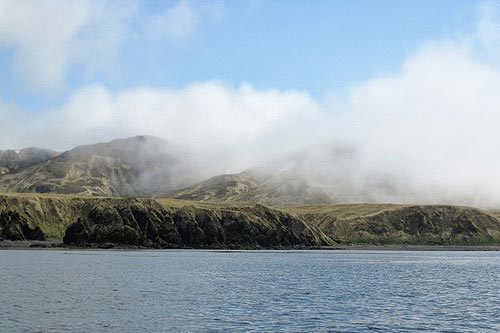
Hawadax Island: A Name Restored in Alaska’s Aleutians;
June 01, 2012
The Aleutian Pribilof Islands Association (APIA), led by President/CEO Dimitri Philemonof, wishes to express appreciation to the U.S. Board on Geographic Names for approving the change of name. “We are also grateful to the three conservation partners of U.S. Fish and Wildlife Service, The Nature Conservancy and Island Conservation whose cooperative efforts led the island restoration that eradicated the infestation of the rats on Hawadax Island. Furthermore, I wish to recognize APIA’s environmental and safety program manager, Ms. Karen Pletnikoff who first expressed the desire to return the island to its historical name and led the effort to submit the petition,” he said.
Hawadax Island The Aleutian Pribilof Islands Association and The Aleut Corp., the regional organizations that serve the stakeholders comprised of Unangas/Unangan people, jointly support the official recognition of the historic name. Hawadax is an Unangan word meaning “those two over there,” a name that quite accurately describes two knolls that dominate the island’s topography. Although it is now uninhabited, the nine-mile-long island was traditionally used by the Unangas/Unangan (Aleut) people for millennia. This name is further supported by attestations recorded in 1840 and again in 1950-1952. The name is still used by speakers in the native village of Atka today. The rocky cliffs and wet tundra of the 11-mile-long island offer ideal habitat for the native seabirds – such as auklets, puffins and murres – that nest throughout the Aleutian chain. The Aleutians support 50 percent of the continent’s seabirds. The restored name replaces Rat Island, a name that lingered for more than two centuries after a Japanese ship infested with rats went aground on the island’s rocky shores in the 1780s. Over time, predatory rats expanded on the island, preying extensively on birds and eggs. Bird populations declined precipitously and though nesting season in the Aleutians is marked by the cacophonous cries of seabirds, the sky over Rat Island grew eerily quiet. A successful seabird habitat restoration in 2009 eradicated the invasive rats. Invasive rats have been eradicated from more than 300 islands worldwide. The Rat Island project was notable in that it was the second-largest island in the world from which rats have been successfully eradicated. Monitoring trips since 2008 have shown native seabird species are benefiting in the absence of rats, including species like the Leach's Storm-petrel, a nocturnal seabird otherwise at very high risk of predation by rats because of their small size and conspicuous calling activity to attract mates. The next monitoring trip will occur in 2013. The uninhabited Hawadax Island lies 1,300 miles west of Anchorage, Alaska or 200 miles from Adak, Alaska. The U.S. Fish and Wildlife Service manages the island as part of the Alaska Maritime National Wildlife Refuge. The U.S. Board on Geographic Names approved the name change at its meeting in Washington D.C. on May 10, 2012. The board maintains uniform geographic name usage in the U.S. and is comprised of representatives of federal agencies concerned with geographic information, population, ecology, and management of public lands.
Related:
Source of News:
E-mail your news &
photos to editor@sitnews.us
|
||
